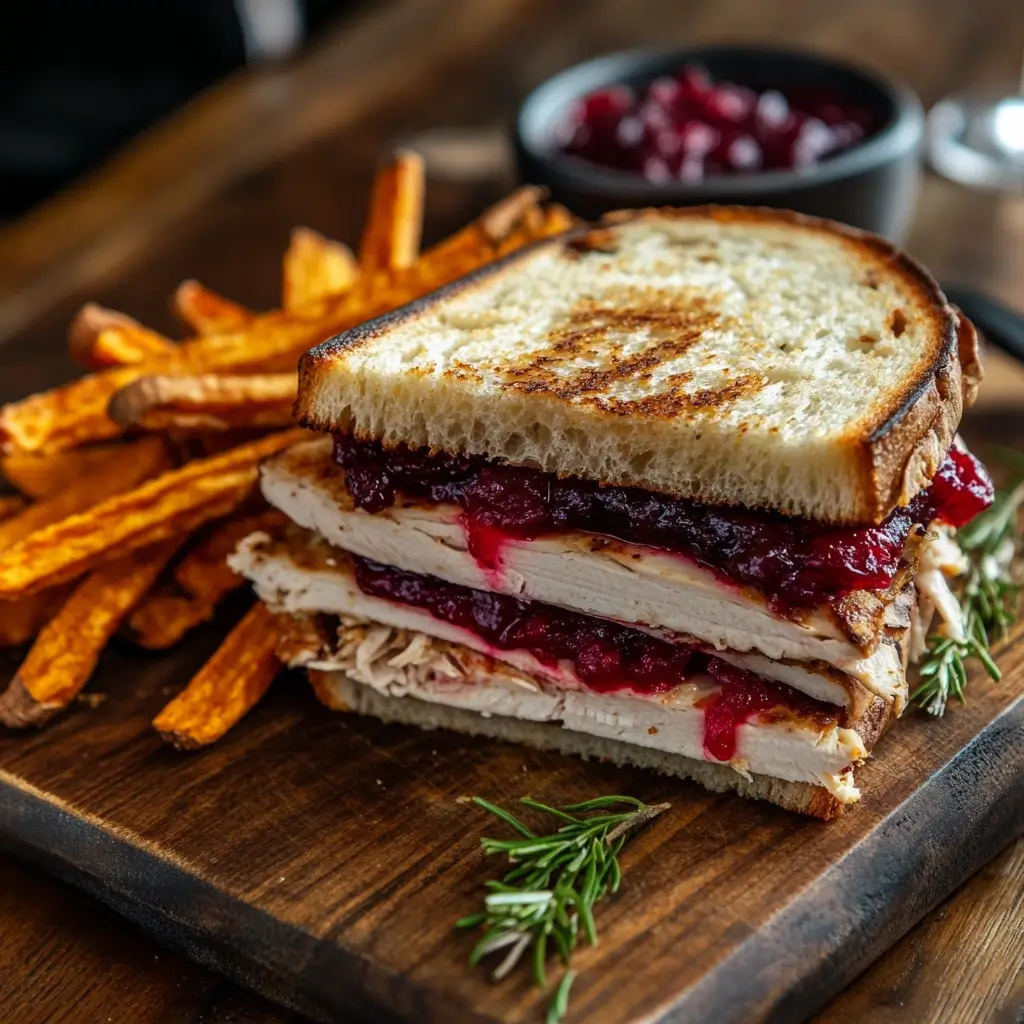Whether you’re planning a cozy Thanksgiving dinner or looking for ways to add a pop of tart-sweet flavor to your everyday meals, canned cranberry sauce deserves a spot in your pantry. This humble can of ruby-red goodness has been gracing holiday tables for generations, yet it’s often misunderstood—or worse, underutilized.
In this guide, we’ll dive into everything there is to know about canned cranberry sauce—from the types available in stores to its surprising versatility in recipes. We’ll explore how to cook with it (spoiler: sometimes you don’t even have to), discover easy ways to jazz it up, weigh the health factors, and even tackle some quirky FAQs. Whether you’re a fan of the smooth, jellied version or prefer it with whole berries, you’ll find something to savor here.
Let’s kick things off with the basics.
Introduction to Canned Cranberry Sauce
What Is Canned Cranberry Sauce?
Canned cranberry sauce is exactly what it sounds like—a preserved version of the classic cranberry condiment, served in either jellied or whole berry form. It’s made by simmering cranberries with sugar and water until the berries pop and thicken into a rich, tangy-sweet sauce. Once cooled, it’s sealed into cans for easy storage and long shelf life.
When you pop open a can, especially of the jellied variety, you might notice it holding its shape, complete with those iconic ridges from the can. Love it or hate it, those ridges have become a nostalgic staple at American holiday dinners, especially Thanksgiving.
Despite its simplicity, canned cranberry sauce delivers a bold, tart punch. It pairs perfectly with savory dishes like roasted turkey, ham, or stuffing, cutting through rich flavors with its sweet acidity. Over the years, it’s become more than just a Thanksgiving must-have—now, people are discovering its uses in everything from cranberry glazes to baked desserts.
The History Behind Canned Cranberry Sauce in American Cuisine
Believe it or not, canned cranberry sauce has a pretty deep-rooted history. It dates back to the early 20th century when cranberry companies like Ocean Spray were looking for ways to make cranberries accessible year-round. The first commercial cranberry jelly in a can hit store shelves in 1941, and it quickly became a holiday favorite.
Part of its rise in popularity had to do with convenience. In the post-war era, American households leaned heavily into canned goods—foods that were easy to prepare and had a long shelf life. Cranberries, which are naturally tart and seasonal, became much more accessible in canned form. And the fact that it could be served cold, straight from the can? That was a game-changer.
Today, while homemade cranberry sauce is trendy, canned cranberry sauce still holds a special place at the table—and in many hearts. It’s one of those foods that instantly sparks nostalgia and brings people together around the dinner table.
Types of Canned Cranberry Sauce
Jellied vs. Whole Berry Cranberry Sauce
Walk into any grocery store around the holidays, and you’ll likely find two main types of canned cranberry sauce sitting side by side: jellied and whole berry. Though they share a common ingredient—cranberries—their textures and uses vary quite a bit.
Jellied cranberry sauce is smooth, firm, and moldable. It slips right out of the can with those unmistakable rings, making it easy to slice and serve. This version is often favored by traditionalists who grew up with it gracing the center of the holiday table.
Whole berry cranberry sauce, on the other hand, is chunkier and more rustic. You’ll find actual cranberry pieces in the mix, giving it a fresher, more homemade vibe. It’s perfect if you’re looking for more texture or want a sauce that can hold its own in baking or savory glazes.
Choosing between the two often comes down to personal preference—or what the recipe calls for. Some folks even like to blend the two for the best of both worlds!
Popular Brands: Ocean Spray and Store Brands Compared
Ocean Spray dominates the canned cranberry sauce game, and for good reason. Their product is consistent, widely available, and has just the right balance of tartness and sweetness. Plus, the brand practically invented the jellied version we all know today.
But don’t overlook store brands. Many offer solid alternatives at a lower price. While some generic options might be sweeter or more gel-like, others are surprisingly close in quality. In fact, taste tests have shown that a few off-brand varieties hold up just as well—especially when used in recipes.
When stocking up, consider grabbing one of each style. You can always use leftovers creatively (check out this roundup of canned salmon meal ideas for inspiration on repurposing pantry staples!).
How to Use Canned Cranberry Sauce
Classic Uses at Thanksgiving and Holiday Dinners
Let’s be real—canned cranberry sauce is practically the poster child for Thanksgiving sides. Served cold or at room temperature, it adds a tangy contrast to the richness of roast turkey, stuffing, and gravy. The jellied version, neatly sliced into discs, fits perfectly on a plate full of mashed potatoes and green beans.
Beyond Thanksgiving, it also plays a starring role at Christmas dinners, where it pairs beautifully with glazed ham or roast duck. Want to make your holiday table extra memorable? Try serving both jellied and whole berry styles in separate dishes—let your guests choose their favorite.
Even better, it’s a stress-free side. No cooking, no stirring, no last-minute prep. Just open the can, plate it, and you’re done. That’s holiday magic in a tin.
Creative Ways to Use Canned Cranberry Sauce Year-Round
Why limit something so flavorful to one season? You can enjoy canned cranberry sauce in all kinds of everyday meals. Spread a spoonful on sandwiches or wraps for a tangy twist—think turkey clubs, leftover chicken wraps, or even grilled cheese. It’s a secret weapon that adds zing to your lunch game.
Got a pork tenderloin or baked chicken to dress up? Warm the sauce with a bit of balsamic or orange zest and drizzle it on top. It also works like a charm as a glaze for roasted vegetables, especially sweet potatoes or carrots.
And don’t forget dessert! Blend it into cream cheese for a tangy dip or bake it into muffins, bars, or cheesecakes. One simple can opens up a world of culinary possibilities.
No doubt about it—canned cranberry sauce is more versatile than it gets credit for. You just have to think beyond the holiday spread.

How to Cook or Prepare Canned Cranberry Sauce
Do You Need to Cook Canned Cranberry Sauce?
Here’s the short answer: nope! One of the biggest perks of canned cranberry sauce is that it’s ready to eat straight out of the can. Whether you’re using the jellied or whole berry version, it’s fully cooked during processing. So, unless you’re tweaking it for a recipe or presentation, there’s no need to heat it up.
That said, warming it gently on the stove or in the microwave can bring out its flavor, especially if you’re serving it alongside warm dishes. A quick warm-up also softens the texture, making it easier to mix into glazes, spreads, or stuffings.
Still not sure what to do with it? Think of it like any other condiment—sometimes it shines best just the way it is.
Serving Tips: Cold, Warm, or Baked into Dishes
Traditionally, canned cranberry sauce is served cold or at room temp. You can slice the jellied variety into rounds for easy plating or spoon the whole berry version into a small bowl for a more rustic vibe. Want to jazz it up? Garnish it with orange zest, chopped nuts, or even a sprig of rosemary.
For warm servings, melt the sauce slightly and mix in a splash of citrus juice, honey, or balsamic vinegar. This elevates it from a simple side to a classy topping for meats or roasted veggies.
You can also fold it into baked dishes. Think cranberry-stuffed chicken breasts, layered casseroles, or even as a swirl in cheesecake bars. It’s subtle, sweet, and adds that perfect punch of tart.
For more delicious recipes with similar pantry staples, check out our canned salmon meal ideas for quick inspiration on using shelf-stable ingredients creatively.
Recipes Featuring Canned Cranberry Sauce
Simple Enhancements: How to Jazz Up Canned Cranberry Sauce
So you’ve opened a can, and now you’re wondering—how can I make this taste a little more “homemade”? Good news: a few simple tweaks can turn that store-bought canned cranberry sauce into something totally next level.
For jellied cranberry sauce, try mashing it up with a fork and adding a splash of fresh orange juice, a pinch of cinnamon, or a spoonful of crushed pineapple. You could also stir in chopped pecans for a bit of crunch or a few chili flakes for a spicy twist.
With whole berry cranberry sauce, the sky’s the limit. Mix in diced apples, fresh cranberries, or even pomegranate seeds for extra texture. A dash of maple syrup or port wine can also add richness and depth. These quick upgrades will wow your guests—and they’ll never guess it came from a can.
Recipes That Use Canned Cranberry Sauce as a Base
Believe it or not, canned cranberry sauce is incredibly versatile in recipes, both savory and sweet. Here are some mouthwatering ways to put that can to work:
1. Glazes for Meats
Combine the sauce with a bit of mustard, soy sauce, or balsamic vinegar to create a killer glaze for pork chops, chicken, or even meatballs. It caramelizes beautifully and brings that sweet-tart balance to every bite.
2. Baked Brie with Cranberry Sauce
Want a show-stopping appetizer? Wrap a wheel of brie in puff pastry, top it with cranberry sauce, and bake until golden. Serve it warm with crackers or apple slices—it’s always a crowd-pleaser.
3. Cranberry Bars and Desserts
Use canned cranberry sauce as a fruit filling in dessert bars, muffins, or cheesecake swirls. It cuts through sweetness with just the right tang. You can even mix it into whipped cream for a quick, festive mousse.
4. Turkey Sandwiches & Wraps
Tired of plain sandwiches? Spread a layer of cranberry sauce on bread or tortillas. It’s amazing in turkey paninis, chicken wraps, or veggie clubs.
5. Holiday Breakfast Boosts
Swirl some into pancake or waffle batter, or use it as a topping with yogurt and granola. It’ll bring a pop of flavor and color to any breakfast table.
From sweet to savory, quick bites to elegant starters, canned cranberry sauce brings color and zing to your kitchen all year long.
Nutritional Value and Health Aspects
Is Canned Cranberry Sauce Healthy?
When it comes to canned cranberry sauce, many folks wonder if it’s actually good for you. The answer? It depends on how you use it and what you’re comparing it to. While cranberries are packed with antioxidants and vitamin C, the canned version often comes with added sugar to balance their natural tartness.
That said, a small serving—about a quarter cup—usually contains 100–120 calories and around 24 grams of sugar. So, while it’s not a health food, it’s not a total no-go either. In moderation, it can be part of a balanced meal, especially during the holidays when indulgence is the name of the game.
If you’re watching sugar intake, opt for low-sugar or “no sugar added” versions. Several brands now offer more health-conscious options that retain the same tangy flavor without the extra sweetness.
Sugar Content and Alternatives
Let’s be honest—most canned cranberry sauces are sweet, and that sweetness mainly comes from added sugar or corn syrup. That’s what gives the sauce its glossy texture and mellow flavor. But if you’re trying to avoid that sugar spike, there are a few tricks you can try.
First, look for varieties sweetened with fruit juice or natural sweeteners like stevia. Some whole berry versions contain less sugar than jellied ones, so check the label. You can also make your own quick “healthier” version by mixing canned cranberry sauce with unsweetened applesauce or freshly mashed cranberries. This reduces sugar per serving and adds fiber, too.
Another tip? Use it sparingly as a flavor booster rather than a full-on side. A tablespoon on a sandwich or spooned into oatmeal adds flair without overloading your plate.
Bottom line: canned cranberry sauce can be part of your table without guilt—just watch the portion size and ingredient list.

Canned Cranberry Sauce in Popular Culture and Tradition
Thanksgiving Traditions and the Role of Cranberry Sauce
Every Thanksgiving, millions of tables are set with turkey, stuffing, mashed potatoes—and, of course, canned cranberry sauce. It’s more than just a side dish. It’s a cultural icon. For many families, the familiar “plop” as the jellied sauce slides from the can is just as important as the turkey itself.
Even though some people poke fun at it, the truth is, that ridged cylinder of sauce brings a comforting sense of tradition. It reminds us of shared meals, passed-down recipes, and childhood memories. And while homemade versions have their fans, there’s something oddly perfect about the canned classic. It’s simple, quick, and delightfully nostalgic.
Over time, it’s become a symbol of the holidays—representing both convenience and continuity.
Internet Memes and the “Plop” Heard ‘Round the Table
Believe it or not, canned cranberry sauce has even found its way into pop culture and memes. Social media lights up every Thanksgiving with jokes, videos, and TikToks showing the satisfying “plop” as the sauce leaves the can. Some even record the sound just for laughs!
People have embraced the kitschy charm of canned cranberry sauce, turning it from a humble side into a full-on holiday character. Whether you love it, hate it, or just enjoy the theatrics of slicing it into perfect rounds, there’s no denying—it’s carved out a permanent place in our holiday hearts.
How to Store and Preserve Canned Cranberry Sauce
Shelf Life of Unopened vs. Opened Cans
One of the great things about canned cranberry sauce is how long it lasts—unopened, that is. Most sealed cans have a shelf life of up to two years when stored in a cool, dry place. That makes them a pantry staple worth stocking up on, especially around the holidays.
However, once you’ve popped the lid, it’s a different story. Opened canned cranberry sauce should be transferred to an airtight container and kept in the refrigerator. It will stay fresh for about 10 to 14 days. Always check for changes in smell, color, or texture before serving leftovers.
Freezing and Refrigeration Tips
Need to keep it longer? Good news—you can freeze canned cranberry sauce. Whether it’s jellied or whole berry, it freezes well for up to two months. Just place it in a freezer-safe container, leaving some room for expansion. When you’re ready to use it, thaw it overnight in the fridge.
Refrigeration is fine for short-term storage, but if you’re using leftovers slowly or batch prepping recipes, freezing is your best bet. For best results, stir well after thawing to restore smoothness and consistency.
So go ahead—buy that extra can (or two). With the right storage, you’ll have cranberry flavor ready to go all year long.
Canned vs. Homemade Cranberry Sauce
Pros and Cons of Canned Cranberry Sauce
Let’s face it—canned cranberry sauce is super convenient. You can slice it, scoop it, or serve it straight from the can. No cooking, no mess, no stress. And for many people, that familiar flavor is exactly what makes the holidays feel like home.
But like anything, there are pros and cons. On the plus side, it’s affordable, shelf-stable, and perfect for last-minute meals. It also offers consistent flavor and texture, especially in recipes that rely on smooth or thick sauces.
On the downside, some varieties are loaded with sugar or preservatives. And while the jellied kind is iconic, it lacks the bright, fresh taste that homemade versions offer. You also won’t get as much control over the ingredients.
Still, when time is tight or you’re feeding a crowd, canned can be a lifesaver.
Why Some People Still Prefer Homemade
Homemade cranberry sauce does have its fans—and for good reason. It takes only about 15 minutes to make, and you can customize it to your taste. Want it more tart? Add less sugar. Craving extra spice? Toss in cinnamon or ginger. The result is a sauce that feels fresher and less processed.
That said, not everyone wants to add one more thing to their cooking list during the holidays. That’s where canned cranberry sauce shines—it’s simple, classic, and ready to serve.
In the end, it’s not about which version is better—it’s about what works for you. Whether you’re team homemade or team canned, both have a place at the table.

